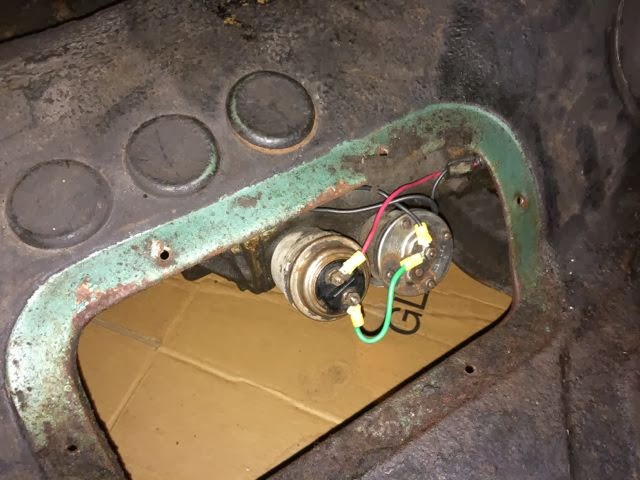Parts found
Found a salvage yard in South Dakota that had some of the stuff we need, parts I wasn't sure we could ever find. We got and installed used letters for the tail gate,
 |
| All in decent shape, not perfect, but suitable for this car. |
the missing S for the hood,
 |
| New S matches perfectly. All letters are now fastened down. |
Most glaring need for parts now is the rear fender moldings that we've never had with this car.
First steps on interior
Some of the seams on the front seat had come unstitched and stuffing was starting to pull out. Resurrection Upholstery, a local shop, pulled the cover off and repaired it with new stitching and backing material. Nice shape for its age, but it is pretty old. Also had the front armrests rebuilt and recovered.
To fasten letters to the tailgate we took it apart. It has been repaired, a bit crudely, but seems structurally OK now. It had clearly been rusty. There are still visible rust stains around the hinges, so we will probably revisit this later. Cleaned up the renewed wood paneling in the rear compartment and replaced several missing or rusty screws. There is a bolt shop just down the hill from here (Ababa Bolt) that has had every stainless screw we have gone looking for. Might have to buy 40 or 100, but they have them. We will be back.
To fasten letters to the tailgate we took it apart. It has been repaired, a bit crudely, but seems structurally OK now. It had clearly been rusty. There are still visible rust stains around the hinges, so we will probably revisit this later. Cleaned up the renewed wood paneling in the rear compartment and replaced several missing or rusty screws. There is a bolt shop just down the hill from here (Ababa Bolt) that has had every stainless screw we have gone looking for. Might have to buy 40 or 100, but they have them. We will be back.
Making it run
When I last posted, the engine had left us stranded a few times when warm. The battery was new, and on one occasion of no cranking, light jumper wires from the main battery junction block to the coil and a nasty, untaped joint in the cranking wire started the car. A new ignition switch arrived, and when we replaced the old one, we replaced or repaired all the old wires that serve it. That seems to have resolved the failure to start.
Finally got around to installing the new spark plug wires, insulators. and distributor cap. The rotor looked new, and besides, CarQuest didn't have it in stock. We've had these parts for months. The wires came in assorted lengths, and we eventually figured out where to put them to get a neat installation. No cutting at all, but we did have to assemble the insulators and the terminals for the distributor cap.
 |
| Neat, and easy enough -- once you get them matched up. |
Phil found and bought Firedome plug wire covers, but we haven't painted them yet, so installing them will wait. Maybe we ought to refinish the the valve covers to match. The plug-tube gaskets around each tube are hard and brittle, so we plan to replace them.
We checked the agreement of wires to distributor cap towers with firing order three times, just to make sure we had it right. Dwell measured 33 degrees, close enough, I decided. When we fired the engine up, it ran like new. Runs smooth, idles, fast response to a throttle blip. Why didn't we do this sooner? The old wires were either misconnected or several were broken. I think at least two cylinders must not have been firing at all. The car now cruises up the hilly streets in our neighborhood and accelerates smartly at freeway speeds. Be nice if it had a higher gear though -- I think its rear end would be perfect for 50 mph gravel roads. We don't drive on those much in San Diego. This engine work was all done last weekend.
Now, about that transmission
Today we got out the shop manual and began diagnostics on the M6 Tip-Toe Shift semiautomatic. The M6 is a four-speed, with two manually selected driving ranges (L and D). Each driving range has an under drive via a countershaft in the main box and a direct drive. The driver selects the driving range with the gear lever, depressing the manual clutch whenever the lever is moved, and an electrical - mechanical - hydraulic system shifts between first and second if in L and between third and fourth if in D. Theoretically.
On this car, upshifts of 1 to 2 and 3 to 4 seemed to work normally. But down shifts were very rare. The driver instructions note that you can drive all day in D, letting the control system select third or fourth as needed. But not on ours. It almost never downshifted at full stops, let alone when speed dropped below 10 mph. Starting out in fourth is disappointing.
The shop manual tells you in a dozen simple steps how to diagnose any M6 difficulty. We used a voltmeter instead of the insulated test lamp it calls for. The problem turned out to be fairly simple: there was no power being supplied to the control elements (solenoid, governor, interrupt switch) and what wiring there was was damaged and incorrectly connected. In a couple of hours, Phil and I made up the wiring harness we needed and ran the checks.
At the transmission, power from the circuit breaker arrives at one terminal on the solenoid. The other is connected to the single terminal on the governor. There are also leads to an interrupter switch under the right-most round cover in this photo.




No comments:
Post a Comment